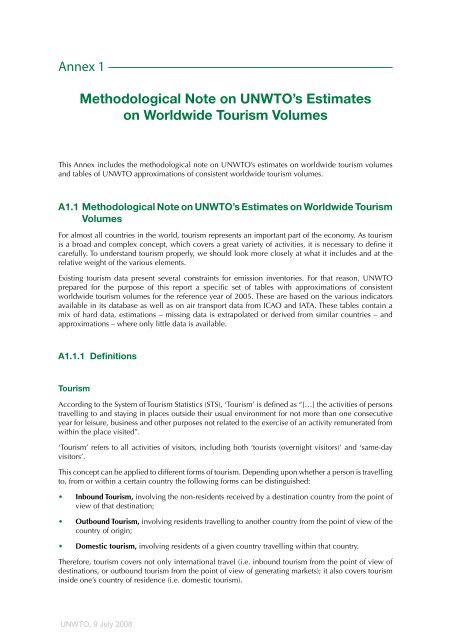Climate Change and Tourism - UNEP - Division of Technology ...
Climate Change and Tourism - UNEP - Division of Technology ...
Climate Change and Tourism - UNEP - Division of Technology ...
You also want an ePaper? Increase the reach of your titles
YUMPU automatically turns print PDFs into web optimized ePapers that Google loves.
Annex 1<br />
Methodological Note on UNWTO’s Estimates<br />
on Worldwide <strong>Tourism</strong> Volumes<br />
This Annex includes the methodological note on UNWTO’s estimates on worldwide tourism volumes<br />
<strong>and</strong> tables <strong>of</strong> UNWTO approximations <strong>of</strong> consistent worldwide tourism volumes.<br />
A1.1 Methodological Note on UNWTO’s Estimates on Worldwide <strong>Tourism</strong><br />
Volumes<br />
For almost all countries in the world, tourism represents an important part <strong>of</strong> the economy. As tourism<br />
is a broad <strong>and</strong> complex concept, which covers a great variety <strong>of</strong> activities, it is necessary to define it<br />
carefully. To underst<strong>and</strong> tourism properly, we should look more closely at what it includes <strong>and</strong> at the<br />
relative weight <strong>of</strong> the various elements.<br />
Existing tourism data present several constraints for emission inventories. For that reason, UNWTO<br />
prepared for the purpose <strong>of</strong> this report a specific set <strong>of</strong> tables with approximations <strong>of</strong> consistent<br />
worldwide tourism volumes for the reference year <strong>of</strong> 2005. These are based on the various indicators<br />
available in its database as well as on air transport data from ICAO <strong>and</strong> IATA. These tables contain a<br />
mix <strong>of</strong> hard data, estimations – missing data is extrapolated or derived from similar countries – <strong>and</strong><br />
approximations – where only little data is available.<br />
A1.1.1 Definitions<br />
<strong>Tourism</strong><br />
According to the System <strong>of</strong> <strong>Tourism</strong> Statistics (STS), ‘<strong>Tourism</strong>’ is defined as “[…] the activities <strong>of</strong> persons<br />
travelling to <strong>and</strong> staying in places outside their usual environment for not more than one consecutive<br />
year for leisure, business <strong>and</strong> other purposes not related to the exercise <strong>of</strong> an activity remunerated from<br />
within the place visited”.<br />
‘<strong>Tourism</strong>’ refers to all activities <strong>of</strong> visitors, including both ‘tourists (overnight visitors)’ <strong>and</strong> ‘same-day<br />
visitors’.<br />
This concept can be applied to different forms <strong>of</strong> tourism. Depending upon whether a person is travelling<br />
to, from or within a certain country the following forms can be distinguished:<br />
• Inbound <strong>Tourism</strong>, involving the non-residents received by a destination country from the point <strong>of</strong><br />
view <strong>of</strong> that destination;<br />
• Outbound <strong>Tourism</strong>, involving residents travelling to another country from the point <strong>of</strong> view <strong>of</strong> the<br />
country <strong>of</strong> origin;<br />
• Domestic tourism, involving residents <strong>of</strong> a given country travelling within that country.<br />
Therefore, tourism covers not only international travel (i.e. inbound tourism from the point <strong>of</strong> view <strong>of</strong><br />
destinations, or outbound tourism from the point <strong>of</strong> view <strong>of</strong> generating markets); it also covers tourism<br />
inside one’s country <strong>of</strong> residence (i.e. domestic tourism).<br />
UNWTO, 9 July 2008

















